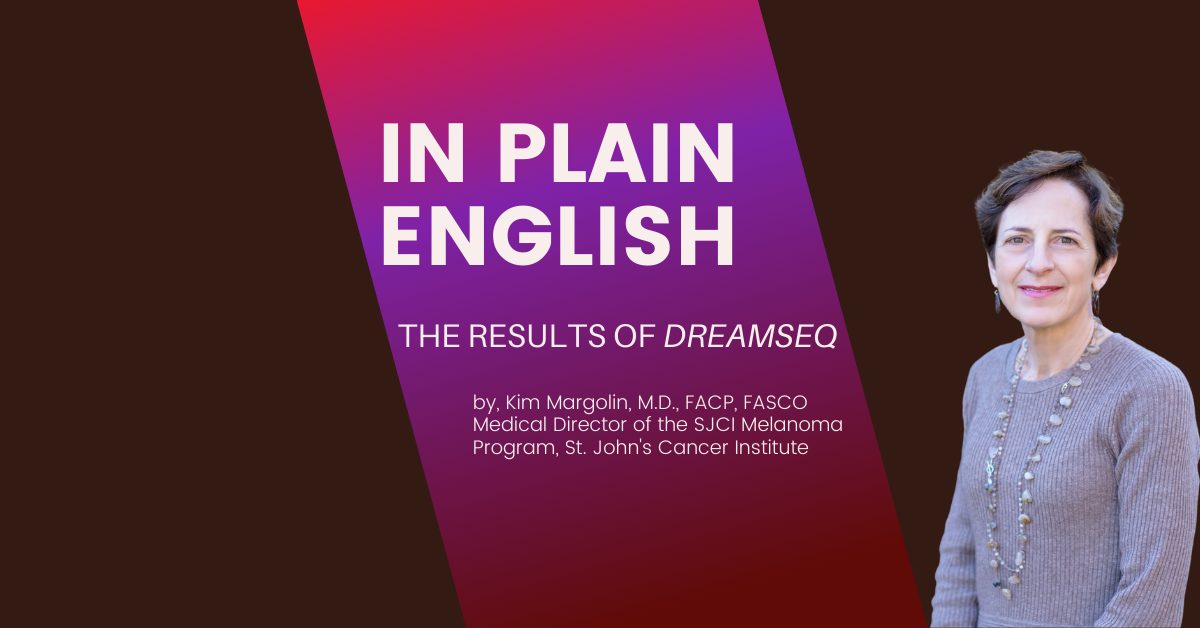In Plain English: The Results of DreamSeq

By Kim Margolin, M.D., FACP, FASCO
Patients with advanced melanoma—spread to other organs or grown too large in the lymph nodes to be safely and effectively removed surgically—that has a BRAF v600E mutation are most commonly prescribed one of two treatments: immunotherapy or targeted therapy. The immunotherapy most commonly given is the combination of a CTLA-4 and PD-1 blockade such as ipilimumab and nivolumab. Targeted therapy consists of inhibitors of two biochemical pathways in melanoma, BRAF and MEK, and there are three choices of such paired inhibitors—vemurafenib plus cobimetinib, dabrafenib plus trametinib, and encorafenib plus binimetinib—all with about the same efficacy but somewhat different side effects. For advanced melanoma patients and their oncologists, one question is critically important: What should be their first treatment, immunotherapy or targeted therapy?
Before now, the answer was unclear. But study results revealed in November 2021 have given us the answer: The best treatment regimen to start with for patients with advanced melanoma whose tumors carry a BRAF v600E mutation is generally a regimen of double immune checkpoint blockade with CTLA-4 and PD-1 antibodies.
Certain patients may be better served by starting with targeted therapies, for example, those with a very high tumor burden who require a quick regression to achieve symptom relief or avoid other disease complications. In the rest of this article, we will explain the background, results, conclusions, and controversies about the DreamSeq trial, comparing in a randomized fashion the outcome of patients starting with double immunotherapy to that of patients starting with double targeted agents, both groups crossing over to the other therapy if their disease progressed (grew or cause worsening symptoms) on the first therapy.
Before we explain the study and the results, let’s revisit the important characteristics of BRAF mutant melanoma and what we know about initial treatment with targeted therapy and initial treatment with immunotherapy.
BRAF Mutant Melanoma
There are actually several types of BRAF mutation in melanoma and other cancers, but in this article, we will be referring to the most common form of BRAF mutation, termed v600E. This mutation leads to the melanoma cell having a hyperactivated BRAF protein that is responsible for much of the melanoma cell’s ability to grow faster, spread through the body, and be more oblivious to normal growth-controlling pathways in the cell.
As with most cancers, there is a subset of patients whose tumors carry a mutation so powerful that it can transform normal cells (in this case mole or pigment cells, called melanocytes) into malignant cells (melanoma) with only a few additional alterations of their genetic material, such as damage from repetitive exposure to the ultraviolet rays in sunlight. BRAF v600E is one of these powerful mutations. About half of all melanomas that arise on skin surfaces carry the BRAF mutation.
Targeted Agents: BRAF and MEK Inhibitors
For BRAF mutant melanoma there are now one or more drugs, deemed “targeted agents,” that can produce remissions by blocking the action of the abnormally activated protein that results from the powerful mutation. These targeted agents are also called BRAF and MEK inhibitors. Fortunately, advanced melanoma is uniquely sensitive to the BRAF and MEK drugs.
BRAF and MEK inhibitors are given orally every day, and they provide an initially very high remission rate (complete or partial reduction of all of the melanoma masses), reported in the 60%s, with additional patients having less dramatic remissions but experiencing some degree of tumor reduction and symptom relief. These drugs also have the very appealing characteristic of inducing rapid remissions, which is a strong advantage for patients with a large tumor burden and symptomatic metastases. Often, patients with a high tumor burden, a rapid pace of growth, and symptoms from their cancer are started on targeted drugs because of their rapid onset of action, with relief of symptoms and regression of metastases literally within days to weeks.
There are, however, some serious limitations to the targeted agents: Not only do they have dose-limiting toxicities in a substantial fraction of patients (and it is uncertain whether patients requiring a dose reduction will have the same likelihood of remission as those who can tolerate full dose), but the melanoma becomes resistant to therapy after an average of about a year. Based on retrospective, nonrandomized data, which can have many biases and inaccuracies (see more detailed explanation below), it has been reported that patients whose BRAF mutant melanoma grows back after a remission from targeted therapies and who then receive immunotherapy have a lower rate of remission than if the same immunotherapy drugs were given as first therapy.
These reports of lower remission rates to immunotherapy in patients previously exposed to and relapsing on BRAF mutation-targeted therapy come from so-called historical or retrospective series, which are simple reviews of patient charts for their clinical characteristics and their treatment outcomes. The problem with retrospective series is that many factors that influence the outcome of therapy (or impact the patient’s prognosis, irrespective of the therapy they get) are not matched up between the groups of patients who started with targeted therapy and those who started with immunotherapy. Also, patients may not undergo tumor assessments (scans, physical examinations, laboratory tests) at the same intervals following the start of therapy, so the calculation of how long they were in remission may be influenced by when they are evaluated. New sites of metastasis can also occur that shorten a remission and threaten the patient’s survival, such as metastasis to the brain, which isn’t always looked at when other tumor assessments are performed.
Immunotherapy with CTLA-4 and PD-1 Blockade
Immunotherapy using CTLA-4 plus PD-1 blocking antibodies given intravenously is considered to be the optimal treatment for advanced melanoma because it has been shown to provide very long term remission in those patients who respond well. As with targeted therapy, one limitation is that patients must be able to tolerate the combination, which is likely to cause immune-related inflammation of many different organs. It is very difficult to determine in advance which patients will not be able to tolerate this combination, other than those with pre-existing major medical illnesses. Even advanced age by itself has not turned out to be a predictor of toxicity or poor outcomes.
Immunotherapy, while providing very long-term remissions in patients who respond well, tends to take longer to start working than targeted therapy, so it has not been as appealing to start with in patients with BRAF mutant advanced melanoma, particularly when it seems to be growing fast. However, the retrospective data referred to in the preceding section also showed that despite lower overall remission rates for immunotherapy and slower onset of action, the ultimate benefit of immunotherapy seems to be greater than that of targeted agents, which rarely provide durable remissions or the potential for cure.
How to Best Answer the Question
It has long been known and accepted that the only way to obtain adequate and balanced data that allow for valid conclusions to be drawn is to perform a prospective, controlled, randomized trial. The definition of these critical terms is that the trial does not involve collecting data obtained in the past from patients who were not enrolled in the trial when they received treatment and underwent tumor assessments (prospective). Rather, patients who provide their informed consent are randomly assigned (by a computer using random number generation) to one of the treatments, and all patients in each treatment group undergo the same treatment, dose, schedule, and tumor assessments and intervals (randomized, controlled). Sometimes factors that might influence the outcome other than the treatment itself—such as a blood test reflecting tumor burden or a subtype of melanoma—are built into the computerized randomization system to assure that both treatment groups are balanced for such factors (stratified).
Informed consent means that patients in clinical trials must agree to the details of the procedures and are, to the extent possible, informed of the expected risks and benefits of all elements of treatment, whether standard or investigational. In some trials, such as the one detailed below, the treatments were both standard (already approved by the U.S. Food and Drug Administration to treat melanoma), but the trial question was about which regimen, started first, conferred the best survival. Patients whose melanoma grew during the first assigned therapy were then crossed over to the opposite therapy as their second-line regimen.
The DreamSeq Trial
In 2011, Dr. Michael Atkins at Georgetown Lombardi Comprehensive Cancer Center, together with selected colleagues in the melanoma field, began what would turn out to be a very long but critically-important quest to define the optimal first-line treatment for patients with advanced melanoma that carried a BRAF mutation. As the trial was moving towards activation, the field changed dramatically for both BRAF-directed therapy and immunotherapy: In the case of BRAF, it was found that a two-drug combination worked better, because the addition of a MEK inhibitor reinforced the BRAF inhibition and prevented secondary non-melanoma skin cancers that sometimes emerge on BRAF-only treatment. In the case of ipilimumab, the addition of nivolumab provided a far more potent regimen, comparable to the BRAF plus MEK combination. Ultimately, the trial of two targeted drugs versus two immunotherapy drugs was opened in July, 2015, and although accrual started slowly, the level of interest in this important question accelerated its momentum. By late 2020, the trial’s Data Monitoring Committee deemed the patient number sufficient to answer the question with statistical significance, which means the numbers would not have come out as they did merely by chance.
The trial’s results were reported by Dr. Atkins in a special ASCO (American Society of Clinical Oncology) session in November, 2021: The survival rates of patients in the two treatment groups were compared at the two-year mark and found to be substantially better for the immunotherapy patients than for the targeted therapy patients (72% versus 52%), thus establishing the superiority of immunotherapy over targeted therapy as the first treatment for patients with advanced melanoma carrying a BRAF mutation.
We will look forward to Dr. Atkins publishing his data for the entire scientific and clinical communities in the near future.
Many questions remain without complete answers, such as:
- Many patients are currently treated with a single immunotherapy drug (PD-1 antibody such as nivolumab or pembrolizumab) rather than two combined immunotherapy drugs (ipilimumab plus nivolumab, as in this study). For these patients, will the effects of immunotherapy using only one drug be as much superior to targeted therapy as immunotherapy with two drugs?
- Will any of the newer (still experimental) immunotherapy drugs be more effective and less toxic than the currently-approved combination of ipilimumab plus nivolumab?
- Is there a way to safely combine or more cleverly sequence the targeted anti-melanoma drugs and the immunotherapy drugs to better exploit the benefits of each class of agent?
Researchers are beginning to answer the second question: There are already very promising data for a new antibody against an immune checkpoint called LAG3, which seems less toxic and at least as effective as the ipilimumab plus nivolumab combination. That combination is likely to be approved by the US FDA soon, which will be encouraging but may raise questions about how it compares with previous regimens. And researchers are trying to answer the third question, too: In a prior issue of In Plain English, we discussed combinations of immunotherapy with targeted therapy and the evidence of some superiority of these combinations over targeted therapy alone. However, there are substantial toxicities of combining three drugs simultaneously, so few oncologists offer them routinely to these patients. There are also plenty of data suggesting that targeted therapy agents can enhance the responsiveness of melanoma cells to immunotherapy, so many investigators are performing clinical trials to probe this question by studying sequences that involve switching from targeted to immunotherapy before the melanoma becomes resistant to targeted therapy.
These are exciting times for melanoma therapy, and it is almost impossible to keep up with the pace of new developments, but we will continue to bring these advances to the melanoma information-seeking public through our In Plain English articles.

Dr. Margolin is a Medical Director of the SJCI Melanoma Program, St. John’s Cancer Institute. She worked at City of Hope for 30 years and also held faculty positions at the Seattle Cancer Care Alliance/University of Washington and at Stanford University. Among her academic achievements were long-term leadership of the Cytokine Working Group, leadership involvement in the Cancer Immunotherapy Trials Network, participation in the Southwest Oncology Group’s Melanoma Committee, and many positions in the American Society of Clinical Oncology and the Society for Immunotherapy of Cancer. Dr. Margolin has reviewed grants for many cancer-related nonprofit organizations and governmental agencies. She has also served as a member of the Oncology Drugs Advisory Committee to the FDA, the American Board of Internal Medicine’s Medical Oncology certification committee, and the Scientific Advisory Committee of the European Organization for the Research and Treatment of Cancer.
Dr. Margolin collaborates with AIM at Melanoma to write the monthly “in Plain English” to provide timely updates on new developments for patients, caregivers, and other individuals with an interest in medical advances in melanoma.
Recent Posts

A Conversation with Dr. Rena Szabo, PsyD on Empowering Patients

Empowering Women in Melanoma: A Look Inside the Women in Melanoma Initiative

Melanoma News and Highlights You Don’t Want to Miss

Coping with Cancer: DBT Skills for Emotional Resilience


